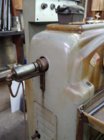My normal disclaimer. I am a permanent amateur newby when it comes to chambering barrels. While I am getting picky about doing things my way, I make no claim my way is remotely the best way....though I am making good shooting rifles.
I discovered that when dialing in a barrel, the throat area needs to be at the pivot point in the chuck jaws. I use 1/16" aluminum shims on the chuck jaws. Here is how I discovered that.
Last week I chambered my first wildcat, a 33-28 Nosler on a New M-70. (Looks like it's going to be a shooter.) It is the first time I have chambered a #4 barrel. All my others have been HV contour. A number four is very bendy......
It was also the longest case I had tried to chamber at 2.5". The other ones I chambered were in 6 BRA and 300 WSM.
I like to dial the throat area to zero, get the breech end as close to zero as I can, and I let the muzzle run out. This is in a 4-jaw, through the headstock, with a spider, and a PM 1340 GT lathe. I use aluminum shims on the chuck jaws and Grizzly rods with a snug pilot to dial in. (I'll double check with an Interapid long reach off the lands.) I use .0002" smaller pilot on the reamer than what I dialed in with.
I had about 2" of the breech sticking out of the chuck. As I was trying to dial in I could get the throat (2.8") to zero runout, but whenever I would use the spider to adjust the breech I would get a lot of runout when I'd recheck the throat. I'd also have a lot of muzzle runout, like .100". I spent hours going back and forth on this. I never had this much trouble with my 6 BRA or 300 WSM.
So I started thinking about it very intently (that's an INTJ thing) and realized the issue. It was not going to be possible for me to dial in the barrel this way. Since I had only 2" of barrel outside the chuck, every time I'd adjust the spider BOTH the breech and throat were moving.
So I dialed the area at the pivot point of the chuck shims to zero, then I dialed the breech to near zero. I checked the throat area and it was maybe .0003". Since this was a hunting rifle in a heavy recoiling cartridge, and I have a floating reamer holder that moves radially AND axially, I called it good. Also, the muzzle only had about .012" of runout.
Going forward I'll make sure the throat area is in the pivot point whenever I can. When I can't, I'll do it like I described above. My only reservation is I'd rather not have 3" of barrel sticking out of the chuck, but since I recheck dial in right before chambering I should be okay. Also, since I am using a chuck vs an inboard spider I do have better grip on the barrel.
I also discovered a better way to initially set up the barrel. I leave the spider loose and then get the outside of the barrel at the chuck to within .001". I then indicate the outside of the muzzle to within .001" with the spider. That makes the barrel fairly concentric with the lathe as I start the dialing in the bore.
For all you real gunsmiths I am sure all this is old hat, but to hobbyists like
@hoz53 and I, it often helps to have an amateur describe what they learned so we can think through things you guys learned and forgot decades ago.....














